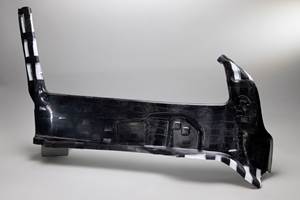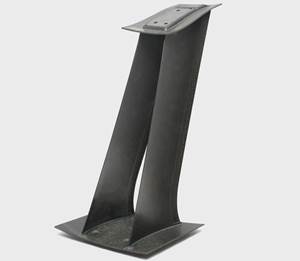NASA all-electric experimental aircraft to begin ground testing
NASA’s X-57 Maxwell has been delivered to NASA’s Armstrong Flight Research Center in its Mod II configuration and will soon undergo extensive ground testing of its integrated electric propulsion system.

NASA’s X-57 Maxwell, the agency’s first all-electric X-plane, is delivered to NASA’s Armstrong Flight Research Center in Edwards, California, in its Mod II configuration. Source | NASA
NASA (Washington, D.C., U.S.) has announced the delivery of the first all-electric configuration of its X-57 Maxwell aircraft — its first crewed X-plane in two decades. The experimental craft is aimed at helping develop certification standards for emerging electric aircraft markets, including urban air mobility (UAM) vehicles. The project’s goal is to further advance the design and airworthiness process for distributed electric propulsion technology for general aviation aircraft, which can provide multiple benefits to efficiency, emissions and noise.
The X-57’s Modification II (Mod II) vehicle, the first of three configurations as an all-electric aircraft, was delivered to Armstrong Flight Research Center (Edwards, Calif., U.S.) by Empirical Systems Aerospace (ESAero, San Luis Obispo, Calif., U.S.) in early October. Mod II features the replacement of traditional combustion engines on a baseline Tecnam P2006T aircraft, with electric cruise motors. The delivery is an important milestone for the project, allowing NASA engineers to begin putting the aircraft through ground tests, to be followed by taxi tests and eventually, flight tests.
“With the aircraft in our possession, the X-57 team will soon conduct extensive ground testing of the integrated electric propulsion system to ensure the aircraft is airworthy,” says X-57 project manager Tom Rigney. “We plan to rapidly share valuable lessons learned along the way as we progress toward flight testing, helping to inform the growing electric aircraft market.”
While X-57’s Mod II vehicle begins systems validation testing on the ground, preparation efforts for the project’s Mods III and IV phases are also underway. The craft’s new, high-aspect ratio wing, which makes extensive use of the latest composites technologies, recently completed load-testing at NASA Armstrong’s Flight Loads Laboratory and will soon undergo fit checks on a fuselage at ESAero.
According to Jeff Viken, research scientist at NASA Langley Research Center (Hampton, Va., U.S.), the aim of the X-57 project is to be able to fly at a 150 KTAS cruise speed on 30% less power than the original aircraft of the same model — a Tecnam P2006T — and also gain the benefits of the efficiency of electric propulsion.
“To reduce airplane drag and increase efficiency, the Mods III and IV wing has been reduced to 42% of the wing area of the original Tecnam aircraft, while still flying the same mission at a slightly greater weight,” says Vicken. “The wing aspect ratio has been increased to 15, and the electric propulsion motors are located at the wing-tips to reduce the induced drag. The thickness of the small X-57 wing is only 4.5 inches at the root.”
According to Viken, the project demanded a unique wing structural design and some of the latest innovations in materials are being used. The wing primary structure is all-composite construction and was built by Xperimental LLC (San Luis Obispo, Calif., U.S.). Three spars make up the backbone of the wing with a mid-chord main spar designed to take all the primary bending loads. The fore and aft spars help stiffen the wing in bending and torsion and provide hard points for the nacelles and flaps. All spars are constructed of Hexcel (Stamford, Conn., U.S.) high temperature and pressure cured prepreg IM2A unidirectional carbon fiber, with a Patz Materials and Technologies (Benicia, Calif., U.S.) PMT-F4 epoxy resin system. To increase the torsional stiffness of the narrow chord wing, the skins are made of the Hexcel’s new technology HexTow HM63 carbon fiber, which is said to be the highest tensile strength, high modulus carbon fiber available. The ±45 skin fiber is non-woven, non-crimped biaxial cloth produced for maximum material properties. The epoxy resin used for the skins is the MGS L285 resin system. The wing-tip nacelles and the nacelles for the distributed spanwise propulsion will be constructed of Toray (Morgan Hill, Calif., U.S.) T700SC plain weave bi-directional carbon fiber fabric.
X-57’s wing recently completed its loads testing up to 120% design limit loads in NASA Armstrong Flight Research Center’s Flight Loads Lab, and is now qualified for flight. Upon completion of Mod II flight testing, the composite Mod III and IV wing will be integrated with the flight fuselage to complete the high-efficiency cruise and low-speed high lift performance testing.
NASA plans to share the experimental aircraft’s electric-propulsion-focused design and airworthiness process with regulators and industry to aid in the advancement of certification approaches for aircraft utilizing distributed electric propulsion.
“NASA’s X-57 Maxwell project is broader than the development an electrified airplane,” says Viken. “In addition to the project’s main goal of developing certification standards for emerging electric aircraft markets, NASA is trying to also demonstrate that when you integrate electric propulsion technology into a vehicle design, that you can better optimize the vehicle.”
The X-57 project operates under the Integrated Aviation Systems Program’s Flight Demonstrations and Capabilities project, within NASA’s Aeronautics Research Mission Directorate.
Related Content
Highly tunable, woven lattice reinforcements target automotive structures
CAMX 2023: Startup Weav3D will be demonstrating its two collaborative automotive demonstrator parts and present two conference papers.
Read MorePEEK vs. PEKK vs. PAEK and continuous compression molding
Suppliers of thermoplastics and carbon fiber chime in regarding PEEK vs. PEKK, and now PAEK, as well as in-situ consolidation — the supply chain for thermoplastic tape composites continues to evolve.
Read MorePlant tour: Albany Engineered Composites, Rochester, N.H., U.S.
Efficient, high-quality, well-controlled composites manufacturing at volume is the mantra for this 3D weaving specialist.
Read More3D weaving capabilities achieve complex shapes, reduce weight and cost
JEC World 2024: Bally Ribbon Mills is displaying film-infused 3D woven joints, woven thermal protection systems (TPS) and woven composite 3D structures.
Read MoreRead Next
Developing bonded composite repair for ships, offshore units
Bureau Veritas and industry partners issue guidelines and pave the way for certification via StrengthBond Offshore project.
Read MorePlant tour: Daher Shap’in TechCenter and composites production plant, Saint-Aignan-de-Grandlieu, France
Co-located R&D and production advance OOA thermosets, thermoplastics, welding, recycling and digital technologies for faster processing and certification of lighter, more sustainable composites.
Read MoreVIDEO: High-volume processing for fiberglass components
Cannon Ergos, a company specializing in high-ton presses and equipment for composites fabrication and plastics processing, displayed automotive and industrial components at CAMX 2024.
Read More






















